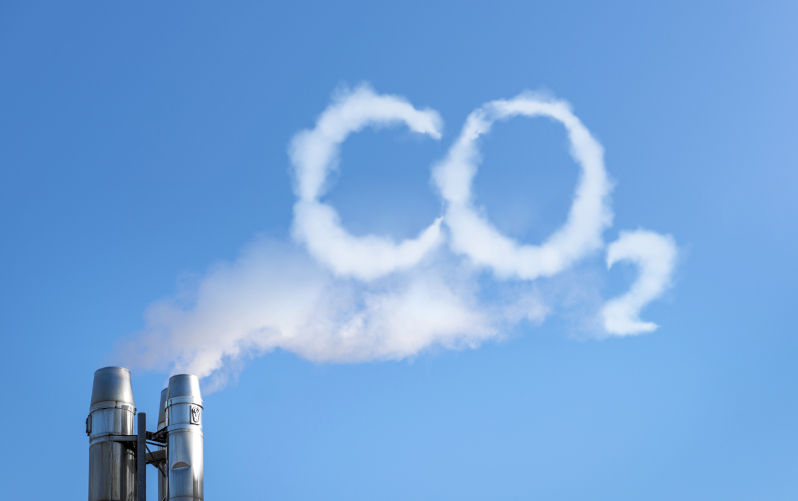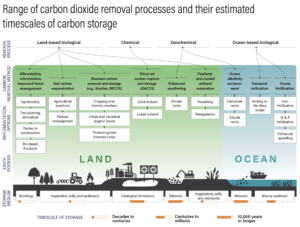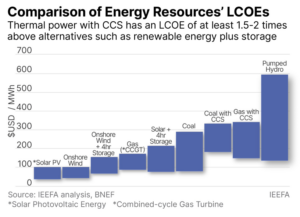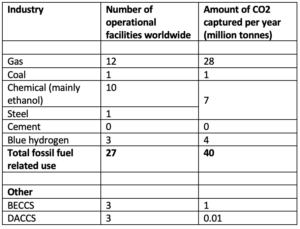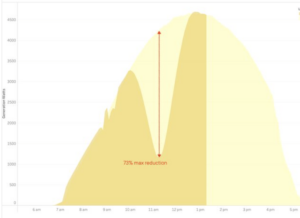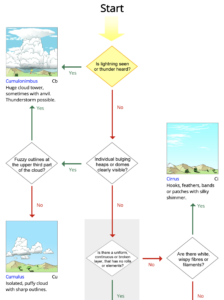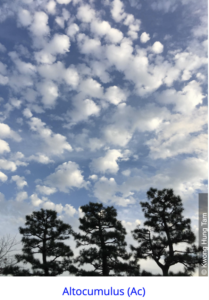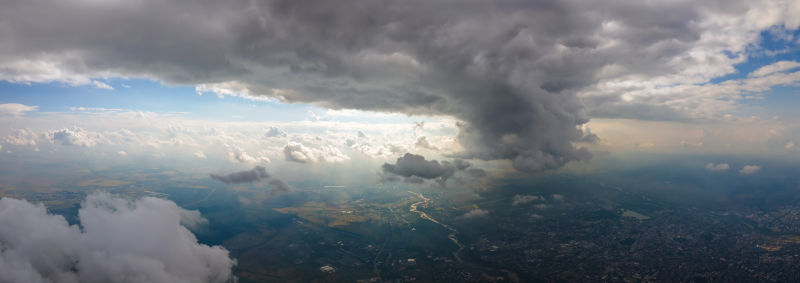Effective carbon capture is needed to stay under 2oC but need does not guarantee supply. A national park in Wales is regenerating culturally and ecologically. Helping you to know your cirrocumulus from your altostratus.
Capturing carbon: where are we? Part 1 of 2
I mentioned a few weeks ago that the most recent IPCC report presented a figure demonstrating that Carbon Capture and Storage (CCS) is currently the least effective and most expensive way to reduce CO2 emissions in both the energy and industrial sectors. Despite this, all credible projections for keeping global warming under 2oC in 2100 are dependent on not only net zero greenhouse gas emissions globally (the most urgent priority) but also carbon dioxide being actively removed from the atmosphere.
But how close are we to making carbon capture an operational reality rather than a projected necessity?
The first thing to clarify is that there are two fundamentally different approaches to capturing carbon. One is to capture carbon dioxide at the point of its generation but before it is released into the atmosphere (for instance at coal-fired power stations and gas wells). Although the terminology gets a bit confusing, this is mostly what is referred to by Carbon Capture and Storage (CCS), or sometimes Carbon Capture and Usage (CCU). The other approach is to capture the carbon dioxide that has already been released into the atmosphere (Carbon Dioxide Removal – CDR). In theory this can occur anywhere around the globe.
There are multiple ‘modern industrial’ technologies potentially available for both approaches, as well as the age-old, natural ‘technology’ of plants absorbing CO2 from the air to use in photosynthesis. Summaries of some of the various approaches are provided in ‘How Does Carbon Capture Work?’ (brief and clearly explained with diagrams) and ‘4 Things to Know About New Developments in Carbon Dioxide Removal’, from which the figure below is taken.
A more critical analysis of the current application of and future prospects for carbon capture is provided by the Institute for Energy Economics and Financial Analysis (IEEFA) in ‘Carbon capture landscape 2022 – still too early to confidently fulfil promises’. This report assesses the potential uses and current market share of several CCS methods in different industries, and the potential of current CCS and CDR applications when judged against five criteria: CO2 capture capacity, technological readiness, commercial readiness, environmental credibility, and social risks.
The main findings of the report are:
- The availability and quality of verifiable data about the CO2 capture rates and the financial performance of operational CCS units is poor. The costs associated with the transport and storage of the captured CO2 are particularly lacking. I wonder why.
- The main application of CCS currently is in the oil and gas industries where the CO2 is separated from the methane when the ‘natural’ gas is pumped to the surface. The CO2 is then injected back into oil wells to increase the supply of oil (‘enhanced oil recovery’). This is simply putting the CO2 back underground to push more oil to the surface where it can be burnt and release more CO2 – apparently some people consider that to be saving the world!
- Capturing the CO2 released by coal-powered electricity plants (‘abated coal’) is not cost-competitive with generating and storing renewable energy. (That’s hardly surprising as unabated coal isn’t cost-competitive and it hasn’t got the additional expense of the CCS.) In practice, however, CCS captures only about 60% at best of the CO2 released when coal is burnt – leaving a lot of CO2 still going into the atmosphere.
- Two industries in which CCS may be worthwhile are the production of ethanol and fertiliser.
- CCS technology in the hard-to-abate steel and cement industries is immature and other technologies for reducing their climate impact may prove more feasible and cost-effective.
- Removing CO2 from the atmosphere (‘negative emissions’) via Bioenergy and Carbon Capture and Storage (BECCS – basically growing and burning plant material to generate electricity) and Direct Air Carbon Capture and Storage (DACCS or often just DAC) are technically and commercially immature, and very expensive, but may become both effective and necessary down the track.
- Carbon capture technologies are not currently good investments. The focus of the energy transition must be on least cost, low-hanging fruit such as further development of renewable energy, grid modernisation and electrification. The chart below clearly demonstrates that solar and wind with storage are the easy to reach, tastiest, juiciest peaches.
I have constructed the table below from information in the IEEFA report. The 40 million tonnes of CO2 captured per year from fossil fuel industries represents about one-thousandth of the current CO2 emissions per year (that’s just CO2, not total greenhouse gases). In fact, it’s about only one-seventh of the annual increase in CO2 emissions over the last decade.
Of course, many new technologies that have been inefficient, unreliable, expensive and slow to grow in their early days have gone on to become ubiquitous and change the world. It may be that one or more carbon capture technologies will pursue a similar successful life. But there’s one crucial difference: it didn’t really matter, except to their investors, how long it took coal power, petrol driven cars, home computers, digital cameras etc. to overcome their teething problems and become established family favourites.
That’s not the case with carbon capture where timing is everything. We have only a few years left to get CO2 emissions under control and none of the carbon capture technologies is going to play a significant role in that challenge. Much better, as the report says, to further refine and roll out the technologies that are already versatile, cheap, safe and effective.
To sum up, my only criticism of the IEEFA report is that the title seems overly optimistic.
Eclipses: natural solar radiation management
Last week’s solar eclipse reached its 76% peak in Perth at 11.30am – three-quarters of an hour before the solar noon. One careful monitor of his home solar system recorded a 73% drop in power output (dark yellow in the graph below) compared with the previous day (light yellow); both days were pretty cloudless. The total duration of the dip in his system’s output was about three hours, not a problem for any domestic or commercial system with decent batteries. Plus, although solar eclipses occur every 18 months, the same place on Earth experiences one much less often.
Australia’s next solar eclipse will be in 2028 when all of the continent will be able to see some of it. The band of totality and near totality will run from the Broome-Derby region to just about the whole of the NSW coast and then on to the south island of New Zealand.
Bannau Brycheiniog – celebrating culture and protecting the future
Australia isn’t the only country that is changing the names of some of its natural features from English to the indigenous language. Wales is pursuing a similar course. As explained in this 5 minute video by (a theatrically sincere) Martin Sheen, the area I have known as the Brecon Beacons National Park, just north of Cardiff and Swansea in old south Wales, is now called the more culturally appropriate Bannau Brycheiniog, ‘the peaks of King Brychan’. While the new name is ‘celebrating Welsh people, Welsh culture, Welsh food, Welsh farming’, the new management plan for the national park is a response to the climate and ecological crises and will provide leadership on decarbonisation.
The name of the video, Cynefin, means habitat or haunt, and Sheen highlights the work that is going into restoring some of the flora and fauna that have been lost in the moorland area over centuries. That said, it has to be noted that there is no native vegetation left in Britain and hasn’t been for centuries. The meadows, hillsides, rivers, woodlands and even mountain tops of Britain are the result of thousands of years of cropping and grazing. Even the quintessentially British rabbit was introduced and, as in Australia, has had a dramatic effect on the local ecology.
What cloud is that?
I think most of us look at clouds now and again and wonder ‘what cloud is that?’ The World Meteorological Association’s International Cloud Atlas (who knew?) has a simple cloud identification guide to help you (top part above). Memorise this and you won’t have your head in the clouds, you’ll have the clouds in … well never mind.
cumulus clouds forming before rainstorm.
Peter Sainsbury is a retired public health worker with a long interest in social policy, particularly social justice, and now focusing on climate change and environmental sustainability. He is extremely pessimistic about the world avoiding catastrophic global warming.
